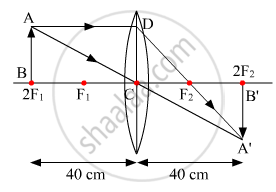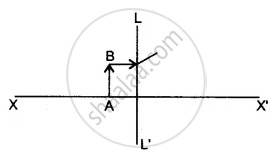Advertisements
Advertisements
प्रश्न
Name the type of lens whose power is positive.
The image of an object formed by a lens is real, inverted and of the same size as the object. If the image is at a distance of 40 cm from the lens, what is the nature and power of the lens ? Draw ray diagram to justify your answer.
उत्तर
The power of a convex lens is positive.
It is given that the image of the object formed by the lens is real, inverted and of the same size as the object. Also, we know that only convex lens can form a real and inverted image. Thus, the given lens is a convex lens. In the given case, the object is placed at 2F1 and the image is formed at 2F2.
It is clear from the figure that the focal length of the lens (f) is 40 cm.
Now, power (P) is given by
APPEARS IN
संबंधित प्रश्न
What is the focal length of a convex lens of focal length 30 cm in contact with a concave lens of focal length 20 cm? Is the system a converging or a diverging lens? Ignore thickness of the lenses.
The lens mentioned in 6(b) above is of focal length 25cm. Calculate the power of the lens.
What is the nature of a lens having a power of + 0.5 D?
The focal length of a lens is +150 mm. What kind of lens is it and what is its power?
On reducing the focal length of a lens, its power ______.
A double convex lens has focal length 25 cm. The radius of curvature of one of the surfaces is double of the other. Find the radii, if the refractive index of the material of the lens is 1.5.
Complete the diagram to show the formation of the image of the object AB.

(i) Name the Lens LL’.
(ii) Where is the image of the object AB formed?
(iii) State three characteristics of the image.
If there is a convex lens of focal length 75 cm and a concave lens of focal length 40 cm, then calculate their combined power and combined focal length.
Match the following:
| Column - I | Column - II | ||
| 1 | Retina | a | Path way of light |
| 2 | Pupil | b | Far point comes closer |
| 3 | Ciliary muscles | c | near point moves away |
| 4 | Myopia | d | Screen of the eye |
| 5 | Hypermetropia | e | Power of accommodation |
The lens of power + 1·0 D is ______.
